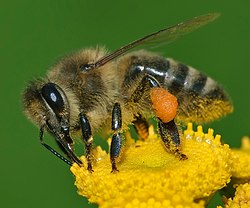Rediviva, f, south africa, side 2014-11-04-13.11.43 ZS PMax (15794500671)
Rediviva species, Black Daddy Longlegs Oil Bee, collected in South Africa
We showed the male already...here is the female.
What fantastically cool bees! These bees have extremely long front legs that they use to collect oil from plants, using the oil instead of nectar as food for the larvae. At the end of their legs are sponge-like patches of hairs. When flying these bees tuck their legs beneath their body and then extend them as they land on their flower. They do this instantaneously. It is like being able to get your arms into the sleeves of a sweater with absolutely no effort. There has been a close evolutionary relationship between the long-legged bees and their oil-bearing floral hosts. The oil is energetically expensive for plants to make and is housed at the end of paired floral spurs. Different species of plant have spurs of varying lengths, some with short spurs only require bee legs of normal length to reach the oil. Clearly this species visits flowers that have very long spurs. The entire range of intermediate leg and spur lengths can be found in these bees which are restricted to South Africa.
17:00, 17 November 2014 (UTC)17:00, 17 November 2014 (UTC){{{{{{0}}}}}}17:00, 17 November 2014 (UTC)17:00, 17 November 2014 (UTC)
All photographs are public domain, feel free to download and use as you wish.
Photography Information: Canon Mark II 5D, Zerene Stacker, Stackshot Sled, 65mm Canon MP-E 1-5X macro lens, Twin Macro Flash in Styrofoam Cooler, F5.0, ISO 100, Shutter Speed 200
Further in Summer than the Birds
Pathetic from the Grass
A minor Nation celebrates
Its unobtrusive Mass.
No Ordinance be seen
So gradual the Grace
A pensive Custom it becomes
Enlarging Loneliness.
Antiquest felt at Noon
When August burning low
Arise this spectral Canticle
Repose to typify
Remit as yet no Grace
No Furrow on the Glow
Yet a Druidic Difference
Enhances Nature now
-- Emily Dickinson
Want some Useful Links to the Techniques We Use? Well now here you go Citizen:
Basic USGSBIML set up: www.youtube.com/watch?v=S-_yvIsucOY
USGSBIML Photoshopping Technique: Note that we now have added using the burn tool at 50% opacity set to shadows to clean up the halos that bleed into the black background from "hot" color sections of the picture.
www.youtube.com/watch?v=Bdmx_8zqvN4
PDF of Basic USGSBIML Photography Set Up:
ftp://ftpext.usgs.gov/pub/er/md/laurel/Droege/How%20to%20Take%20MacroPhotographs%20of%20Insects%20BIML%20Lab2.pdf
Google Hangout Demonstration of Techniques:
plus.google.com/events/c5569losvskrv2nu606ltof8odo
or
www.youtube.com/watch?v=4c15neFttoU
Excellent Technical Form on Stacking:
www.photomacrography.net/
Contact information: Sam Droege sdroege@usgs.gov
301 497 5840Relevante Bilder
Relevante Artikel
MelittidaeDie Melittidae ist eine kleine Familie von Bienen. Es sind etwa 200 Arten und 14 Gattungen bekannt. Alle Arten sind solitär und nisten im Boden. Viele der Arten sind oligolektisch, also auf bestimmte Pflanzenarten spezialisiert. Eine Besonderheit der Melittidae ist, dass in dieser Familie „Öl-Sammeln“ vorkommt. Arten der Gattungen Rediviva und Macropis haben spezielle Haare an den Vorder- und Mittelbeinen, mit denen sie Öl sammeln, das den Larven zum Pollen als Nahrung in die Nester deponiert wird. Das Öl stammt aus Blüten, z. B. von Lysimachia, die in Elaiophoren Öl absondern. Auch eine ausgestorbene Art, die in Bernstein gefunden wurde, hatte Haare, die zum Öl-Sammeln gedient haben dürften. .. weiterlesen















